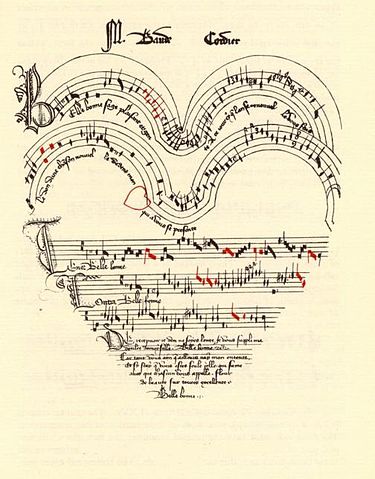 |
This is a file from the Wikimedia Commons. Information from its description page there is shown below.
Commons is a freely licensed media file repository. You can help.
|
Summary
| Description |
Score of Baude Cordier's chanson "Belle, bonne, sage," from The Chantilly Manuscript, Musée Condé 564. The manuscript is one of the classic examples of ars subtilior, which requires red notes, or "coloration" to indicate changes in note lengths from their normally written values. This chanson, a dedicatory piece on the love of a lady and a lord written in the shape of a heart, opens the corpus. Note the heart of notes within the larger heart. |
| Date |
ca. 1350-1400 |
| Source |
Chantilly Manuscript |
| Author |
Baude Cordier |
Permission
( Reusing this file) |
Pub. domain
|
Licensing
 |
Permission is granted to copy, distribute and/or modify this document under the terms of the GNU Free Documentation License, Version 1.2 or any later version published by the Free Software Foundation; with no Invariant Sections, no Front-Cover Texts, and no Back-Cover Texts. A copy of the license is included in the section entitled GNU Free Documentation License. http://www.gnu.org/copyleft/fdl.htmlGFDLGNU Free Documentation Licensetruetrue
|
File usage
The following pages on Schools Wikipedia link to this image (list may be incomplete):
All five editions of Schools Wikipedia were compiled by SOS Children. SOS Children's Villages believes that a decent childhood is essential to a happy, healthy. Our community work brings families new opportunities through education, healthcare and all manner of support. There are many ways to help with SOS Children's Villages.



